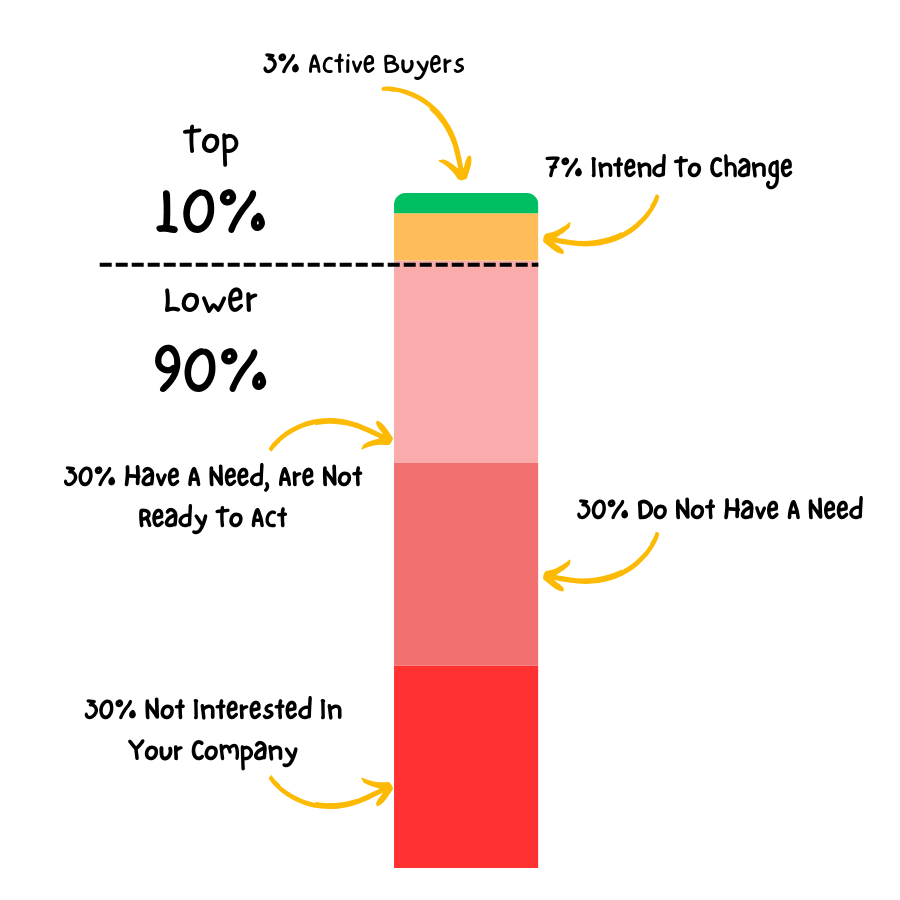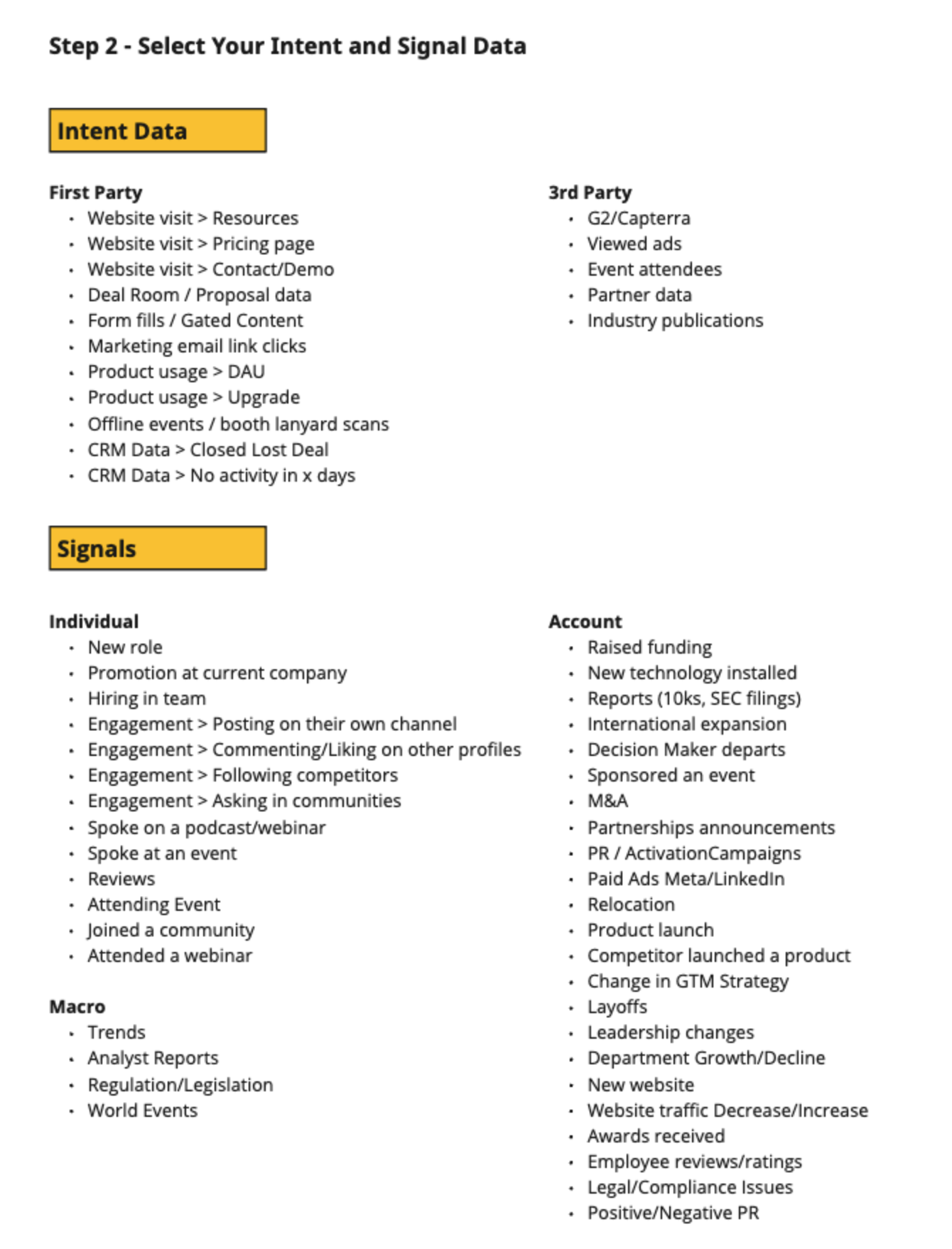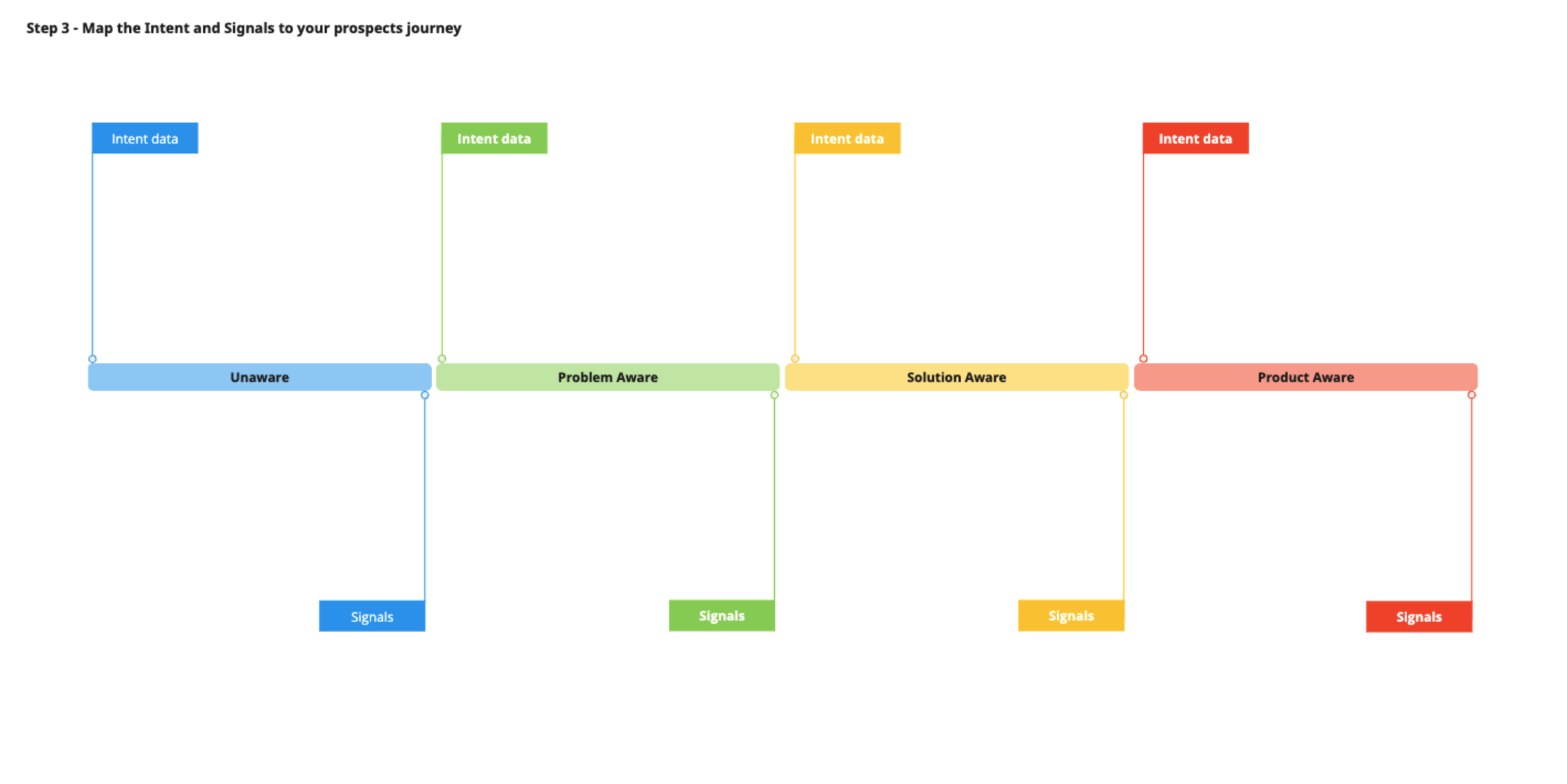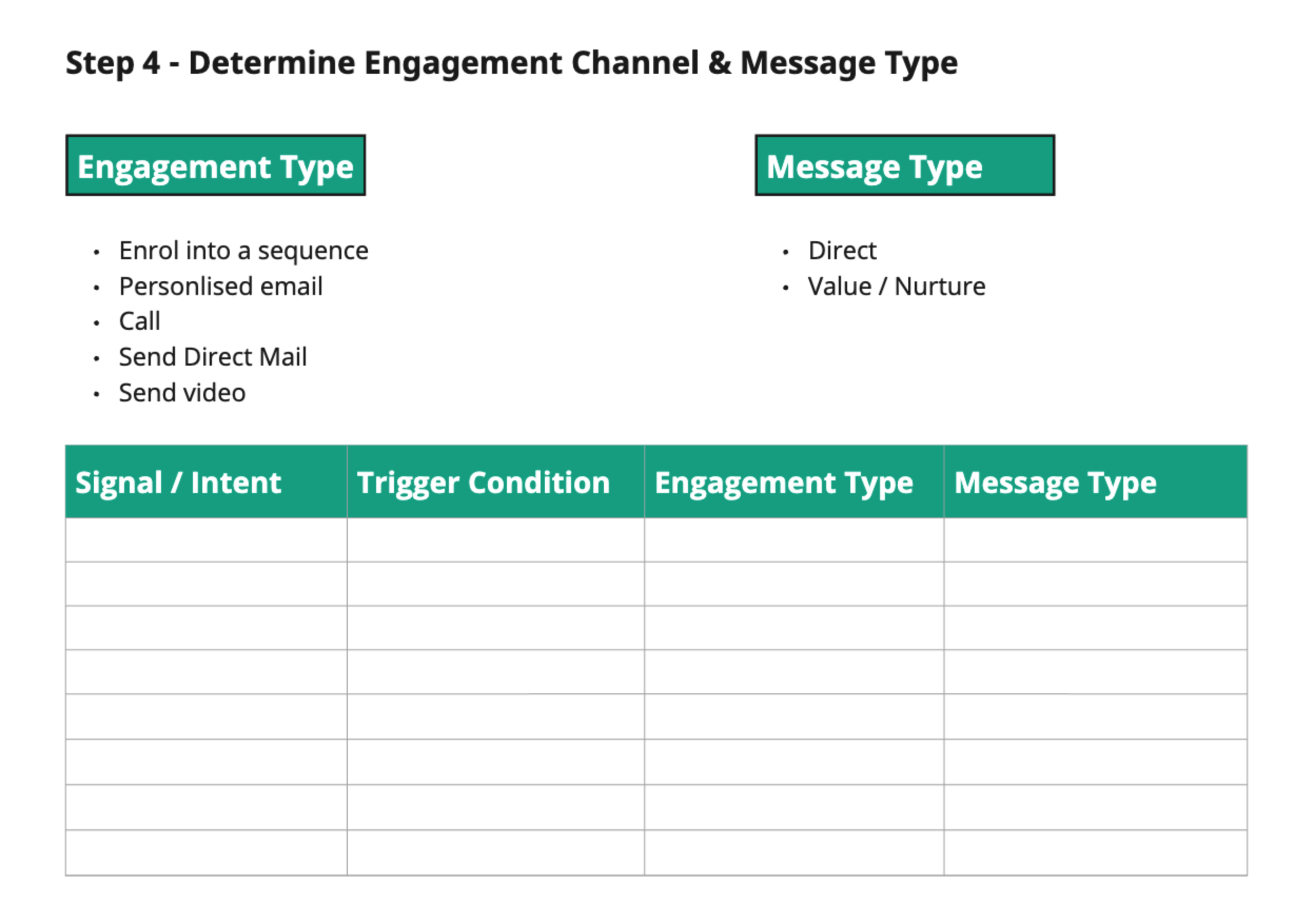Trigger Based Prospecting & How To Use Intent Data & Signals In Your GTM Strategy
Table of Contents
This is part 1 of a 3 part series on Trigger Based Prospecting.
- Trigger Based Prospecting & How To Use Intent Data & Signals In Your GTM Strategy (this post)
- Data Sources And Tools For Intent Data and Signals (coming soon)
- Example Trigger Campaigns & Email Copy (coming soon)
Introduction
There’s a lot of talk about intent, triggers and signals in the outbound space at the moment.
And I’m happy to see it for 2 main reasons:
- Spray and pray prospecting which never really worked is coming to an end as companies can’t afford to risk their domain and business reputation.
- The technology has finally caught up with dozens of providers offering intent and signals data that can now seamlessly plug into your CRM and Sales Engagement Platform.
This post isn’t going to be about my recommendations for which tech vendor to use for specific intent or signals.
Instead, it will be focussed on the thought process, strategy and implementation of this data to help you future proof your sales led GTM strategy.
Before diving into the content, I want to share my definitions which will be used throughout this post.
Intent data
Intent data provides insights into the online behaviours of a target audience. It’s also known as buyer intent data or purchase intent data.
It “predicts” whether a buyer intends to make a purchasing decision in your industry.
Signals
Are actions or events prospective buyers (people and companies) take that may indicate they will soon be in need of a solution or they’re close to making a purchasing decision.
Triggers
The moment that a signal or intent event has occurred which starts the process of engaging with a prospect.
Triggers happen dynamically and due to this nature, it’s hard to predict total trigger events each month.
Others often refer to triggers and signals interchangeably, but the above is my interpretation.
It’s also worth noting the following:
- Not all signals and intent data should be treated as equal. Some are more indicative of a purchasing decisions than others.
- Some signals can be used more for adding context than anything else.
- You can combine multiple signals and intent to increase the chances of receiving a positive response.
- Signals and intent data is not a silver bullet, but it is certainly more effective than the spray and pray approach to prospecting.
Why You Need To Focus On Intent Data & Signals
In short, it’s about sending the right message to the right person at the right time.
Back in 2007, Chet Holmes (The Ultimate Sales Machine) shared that only 3% of your market are actively buying at one time.
7% intend to change soon and 90% are not “in-market”.
Today, most businesses still build a list of companies they want to sell to, find a few contacts and enrol them into a generic sequence.
Without even thinking about the 10% in market or the 90% not in market.

But in reality, pipeline campaigns are won and lost on relevancy.
And it looks like most are losing at the moment.
In 2023 (according to Pavilion’s State of Sales Development Survey):
- 73% of SDRs missed quotas.
- Pipelines shrank by 50-100% YoY.
I personally believe that this is down to a few things:
- Running an outdated playbook that unintentionally companies interpreted as quantity over quality. And focus on short term activity metrics over longer term impact.
- Out of touch Sales and Marketing leaders that are slow to adapt to the changes in buyer behaviour and the wealth of information they (the buyers) now possess.
- Lack of an in-depth understanding of the challenges and problems faced by their target audience.
Betts, a Go-To-Market Recruiting Agency shared the following in their latest compensation guide:
“With the accelerated adoption of AI, outbound emailing success plummeting, and cold calling considered outdated for the new generation of SDRs, companies are reassessing their SDR programs. With some even bypassing these programs altogether.”
Ouch – Looks like the SDR’s are going to take the fall for outdated strategies, bad management and changing buyer preferences.
So what’s the answer?
While none of us possess a crystal ball and can read the minds of prospects or peek inside the boardrooms of companies, intent data and these signals can give us an indication that starting a conversation with a prospect now might be a good idea.
This moment for a prospect or a company is how I define a trigger event.
And you can now use technology to monitor these events, which should be integrated into the daily workflow and activity of sales reps.
I’m not suggesting that sales organisations should only engage with prospects based on trigger events.
But I am suggesting that we stop sending generic emails without considering the stage of a prospect or company.
And instead take a different approach to prospecting, which I’ll explain in more detail later.
Intent Data and Signals
Intent Data
As shared previously, intent data provides insights into the online behaviours of a target audience. It’s also known as buyer intent data or purchase intent data.
It “predicts” whether a buyer intends to make a purchasing decision in your industry.
There are two types of intent data 1st party and 3rd party (I’m not sure what happened to 2nd party data).
1st party data can be simply understood as data that you own.
It uses cookies and IP addresses to follow leads on your website, product and other platforms.
1st Party Data
Examples of 1st party intent data includes:
- Website visits
- Resources
- Pricing page
- Contact/Demo
- Form fills / Gated content
- Marketing email link clicks
- Deal Room / Proposal data
- Product usage
- DAU
- Upgrade
- Offline events / booth lanyard scans
- CRM Data
- Closed Lost Deals
- No activity in x days
3rd Party Data
3rd party data on the other hand is data collected from another website.
This data is then either sold to you directly or managed by an intermediary and packaged up.
Examples of 3rd party data includes:
- G2/Capterra
- Viewed ads
- Event attendees
- Partner data
- Industry publications
1st and 3rd party intent data can give you insights as to where prospects are in their journey, but it doesn’t automatically mean that this is a prospect that wants to buy right now.
Someone visiting your pricing page – could be researching for a blog post.
Someone at an event – could be there just to learn.
Someone downloading an ebook – could be compiling a blog post.
Where 1st party data is more telling, in my opinion, is when it is utilised later in the sales process during the proposal stage or in product when a user reaches the limit of their free plan, but has logged in every day.
So, that’s intent data. I’m not too convinced about the effectiveness of a lot of this data for prospecting.
However, signals are a much better indicator for outreach.
Signals
There are 100’s of signals you could look to capitalise on, but the ones you pick depend on what you’re selling and who you’re selling it to.
Signals can be seen as the actions prospective buyers (people and company) take that may indicate they will soon be in need of a solution or they’re close to making a purchasing decision.
I’ve included links to some brilliant resources on signals which you can find at the end of this post.
Below are examples of different signals split by individual, account and macro levels. Most are self explanatory.
Individual level signals
- They start a new role
- Promotion at current company
- Hiring in team
- Engagement
- Posting on their own channel
- Commenting/Liking on other channels
- Following competitors
- Asking in communities (Slack, Whatsapp etc)
- Spoke on a podcast/webinar
- Spoke at an event
- Reviews
- Attending Event
- Joined a community
- Attended a webinar
Account level signals
- Raised funding
- New technology installed
- Reports (10ks, SEC filings)
- International expansion
- Decision Maker departs
- Sponsored an event
- M&A
- Partnerships announcements
- Campaigns
- Meta/LinkedIn Ads
- PR/Activations
- Relocation
- Product launch
- Competitor launched a product
- Change in GTM Strategy
- Layoffs
- Leadership changes
- Department Growth/Decline
- New website
- Website traffic Decrease/Increase
- Awards received
- Employee reviews/ratings
- Legal/Compliance Issues
- Negative PR
Macro level signals
- Trends
- Analyst Reports
- Regulation/Legislation
- World Events

Real life examples of triggers
- Hubspot CRM Consultant – New Technology Installed – Started using Hubspot
- Content Marketing Agency – Currently Hiring in their Marketing team
- Product Onboarding Service – Engaged with LinkedIn (talking about Product Onboarding)
- Paid Ads Service – Decrease / Increase in Ad Spend
- Email Marketing Service – New To Role and New Technology
- SEO Service – Decrease in website traffic
- Employee Onboarding Software – Raised Funding
- Shopify Development Service – Exploding Trends (i.e Padel)
- Recruitment company – Currently Hiring and New to Role
- Network Security – Office relocation
- Remote Work Collaboration Software – World Events (Covid)
A Note On Why People Buy
At this point, it’s worth reminding ourselves of some basic sales psychological principles.
In the world of B2B, more than 70% of purchasing decisions are made to avoid a loss or a pain.
In addition to this, companies make purchasing decisions for the following 5 reasons:
- Save Money
- Save Time (Efficiency)
- Make More Money
- Grow By Hiring, Onboarding & Training New Employees
- Mitigate Risk
Intent data and signals therefore create triggers that align with one of the 5 reasons above of why people buy (sometimes it can be more than one reason).
How To Implement Triggers In Your Sales Led GTM
Hopefully by now I’ve convinced you to start considering why these signals and intent data should be included in your prospecting efforts.
But so far, I haven’t explained how.
There’s a fair amount of investigative work that goes into determining the right signals and intent data. this out.
But if I was to simplify it, here are the main steps I walk my clients through:
- Determine which signals and what intent data is most relevant for your prospects, the industry you sell into, your product and your pricing.
- Ask – what is happening to my prospects’ work life before they need my solution?
- Map these trigger events across the 5 stages of customer awareness, as outlined by Eugene Schwartz in his copywriting classic “Breakthrough Advertising” (one of my favourite books alongside Claude Hopkins, Scientific Advertising)
- Select the correct data sources for intent and signals
- Integrate these data sources with your CRM and Sales Enablement tool, ensuring that this data is cleaned, enriched and verified.
- Create engagement campaigns and workflows (see more info below)
- Set up trigger conditions and connect these to your campaigns and workflows.
Once implemented, you can essentially automate a lot of your activity to the 10% of your prospects that are likely in market.
This results in the right message, going to the right person, at the right time.
The 5 Stages Of Customer Awareness
I’ve mentioned above that not all intent data or signals should be viewed as equal.
And some can be used more for context to increase the relevancy of your message.
The closer the trigger events are to the “product aware” stage, the stronger the trigger is.
In these cases, we use very direct and personalised messages to evoke a response.

Engagement Type And Message Type
The next stage of the implementation process is to work out the engagement type and the message type.
The different engagement types include:
- Enrol into a sequence
- Personalised email
- Call
- Send Direct Mail
- Send video
And the different message types include:
- Direct – mentioning the challenge and highlighting a solution
- Nurture/Value – play the long game and help the prospect overcome their immediate challenges while seeding your solution and company as a potential option in the future.

I’ve recorded a video which walks through How To Select Intent Data & Signals To Build Trigger Based Pipeline Generation Campaigns in more detail (at the end of this post).
It covers steps 1 and 2, which are the strategic elements to running trigger based prospecting campaigns.
Because of the nature of the intent data and signals and your specific use case, it’s challenging to write a one to many piece of content that gives you the exact answer and points you to the right data source.
But you can access the miro board here to at least start plotting the signals and intent data along the stages of customer awareness that you should invest in to future-proof your sales led GTM motion.
I’ll conclude this post with the following excerpt from Jacco van der Kooij’s article: Has SaaS Lost Go To Market Fit? And What To Do About It.
“The dual approach of optimizing human-led processes and leaning into product-led and AI-enhanced GTM ensures operational excellence now and competitive superiority in the future.”
Implementing trigger based prospecting is just one way to enhance your GTM strategy. But by the end of 2024, it will be essential.
If you’re struggling to work out your competitive superiority, simply email [email protected] and let’s go hunt that 10% together.
Additional Resources On Signals And Triggers:
Work With Us
Need To Future-Proof Your Pipeline?
We optimise existing & build new intent, trigger & nurture based outbound campaigns that generate pipeline (and you can run yourself).

